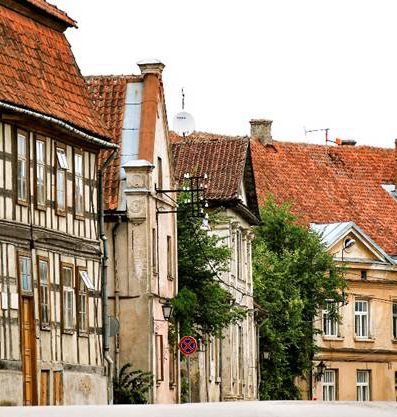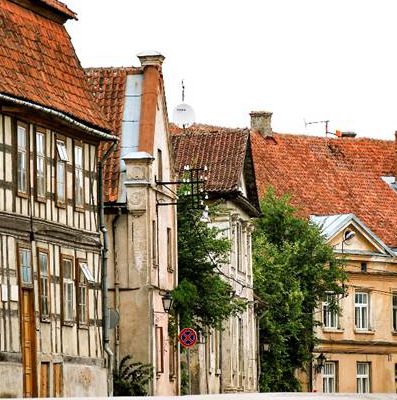Due to its rich cultural heritage, this territory is included in the Latvian national list of UNESCO World Heritage.
The Latvian National Commission of the United Nations Educational, Scientific and Cultural Organization (UNESCO) in Latvia coordinates the activities of the UNESCO World Heritage Program and ensures the implementation of the UNESCO Convention on the Protection of Cultural and Natural Heritage. In 2011, the Assembly of the Latvian National Commission of UNESCO approved the nomination "Kuldīgas old town in Ventas senlejā" in the Latvian national list of UNESCO World Heritage.
The main values of the nomination included in Latvia's national list of UNESCO world heritage are the territory, buildings, objects of "Kuldīga old town Venta senlejā":
- The old town of Kuldīga - including the medieval village of Kalnamiesta, combining them into a wider urban environment, which was formed between the 16th and 18th centuries and later expanded, mostly outside the historical center, in the 19th and further into the 20th centuries. The area covers the expansion of the city until the 19th century and its important location in nature. The place is currently mostly preserved according to the condition of the 18th and 19th centuries. Therefore, it includes the complete historical heritage of Kurzeme, which has been preserved until today. This is especially evident in the unchanged urban planning, architectural evidence and carpentry details. As well as the red tiled roofs in the landscape.
- architectural monument Red brick arched bridge (date: 1874);
- Venta canal (dating: 17th-19th century);
- Alekšupīte waterfall – the highest waterfall in Latvia at an altitude of 4.15m (date: 17th century);
- Ventas rumba – the widest waterfall in Europe (width 240m, height 1.8-2.2m).
The integrity and authenticity established when preparing the materials for receiving the nomination for World Cultural Heritage status, in the sense of World Cultural Heritage, is:
– Thanks to the strict legal prohibition in the historic city, and the well-maintained urban conservation area.
– The urban environment and architectural heritage of Kuldīga is well preserved both in terms of materials, design and execution. The city continues to function in the local community, both for housing, auxiliary buildings and commercial space. The old town has also preserved its authenticity in terms of the surrounding environment and location. Here, not only the planning and size of the city, but also the overall urban landscape around the Venta river have been preserved.
On February 28, 2020, the municipality of Kuldīgas region submitted an application prepared in accordance with the UNESCO Convention on the Protection of World Cultural and Natural Heritage to the Latvian National Commission of UNESCO. It was prepared on the basis of two extensive scientific studies: J. Krastiņš "Kuldīga. Architecture and urban planning", A. Melluma "Kuldīga. Times, people, landscape" to justify the nomination of Kuldīga at the World Heritage level. In the UNESCO World Heritage Center, the nomination was accepted under the new name "Kuldīga (Goldingen)". Based on the data of scientific materials, identifying and mapping unique attributes in the urban environment, it was concluded:
The old town of Kuldīga is the best-preserved and last remaining evidence of the urban environment, which is reflected in the layout of the streets and plots of land with essential preserved elements of the architectural character and infrastructure from the times of the Duchy of Kurzeme and Zemgale. The following are emphasized as the main World Heritage values:
Kuldīga provides a unique testimony of the Duchy of Kurzeme and Zemgale and its era of prosperity, international trade relations and cultural exchange, both as the residence of the first ruler and as an administrative center. Kuldīga has preserved not only the city planning, but also the image and remarkable architectural form, the origins of which can be traced back mainly to the 17th and 18th centuries. With the fact that up to three-quarters of the masonry architecture built up to the 19th century has been partially or fully preserved in the city, Kuldīga is the best and last remaining evidence of the urban environment of the Kurzeme era. The historical center of Kuldīga, which has been preserved in good condition, is a reminder of the prosperity and trade development of Kurzeme in the 16th, 17th and 18th centuries, when the city was known as Goldingen. Kuldiga was the main residence and administrative center of Duke Gotthard Ketler, the first ruler of Courland, since 1561. During the co-rule of Gotthard Kettler's heirs, Goldingen was the residence and administrative center of Duke Wilhelm Kettler, who was granted power over Kurzemi in 1596 and who ruled until 1616. In the census of 1613, it was documented that there were 175 buildings in Kuldīga. In addition to the traditional log buildings, Kuldīga also had brick buildings, wooden construction buildings, which were often decoratively plastered and painted, as well as buildings covered with wooden panels - both residential and auxiliary buildings. Kuldīga's architecture flourished due to the rich exchange of traveling craftsmen from other Hanseatic cities and centers around the Baltic Sea, as well as from Russia, which is still evident in the city's architectural style, crafts and decorations. In 2007, "The city of Kuldīga in the ancient valley of Venta" was recognized as the most outstanding tourist destination in Europe, while in 2008, the historical center of the city of Kuldīga was awarded the European heritage mark.


Ceru, ka Kuldīga beidzot būs UNESCO!